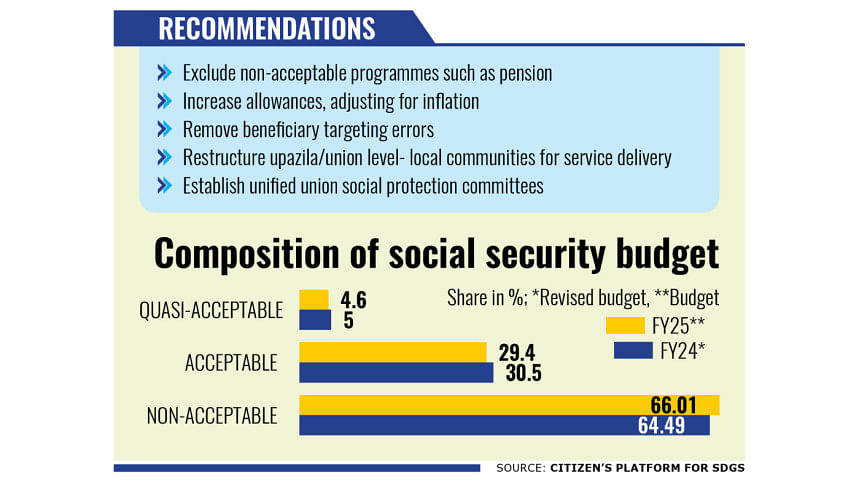Two-thirds of social protection allocations not genuine

Nearly two-thirds of the allocations under this fiscal year's social security budget do not qualify as genuine social protection spending, according to a study by the Citizens Platform for SDGs, Bangladesh.
The platform classified the 140 existing social safety net programmes into three categories: acceptable, quasi-acceptable (mainly loan and training schemes), and non-acceptable -- those that should be excluded from the social protection framework.
It found that only 29 percent of the allocation is considered "acceptable" -- programmes that should naturally be included in the social protection list. Only 4.6 percent is quasi-acceptable, and the rest is not acceptable, the study said.
"Regrettably, the social protection budget has been unrealistically inflated over the years by increasing the share of 'non-acceptable' programmes, which have no relevance to the Leave No One Behind (LNOB) principle," said Debapriya Bhattacharya, the platform's convenor.
He was addressing a dialogue titled "Bangladesh Economy 2025-26: Policy Reform and National Budget" organised by the platform at Lakeshore Hotel in Dhaka yesterday.
In FY25, non-acceptable programmes with little relevance to the LNOB policy account for 66.01 percent of the social security budget -- up from 64.49 percent in the revised FY24 budget.
From the revised budget for FY24 to FY25, the share of acceptable and quasi-acceptable programmes declined by 3.61 percent and 8 percent respectively, while the share of non-acceptable programmes rose by 2.36 percent, the study noted.
In FY25, pension management alone accounts for 96.40 percent of the total allocation under acceptable social protection programmes, it added.
Over half of the poor and vulnerable families are not receiving social protection benefits, while 62 percent of non-poor and non-vulnerable households are receiving them, it said, citing the Household Income and Expenditure Survey 2022.
This is mainly due to reliance on traditional means of targeting, the lack of an integrated database, corruption associated with the implementation of such programmes, and the absence of a functional grievance redressal system (GRS), said the platform.
Bhattacharya suggested raising the allowance for social protection schemes, particularly old-age allowance, allowance for widows and allowance for persons with disabilities.
The platform welcomed the government's move to shift the allowance payment method and expand the beneficiary list, as the government plans to add another 10 lakh recipients.
"The decision to shift the allowance payment method and expand the beneficiary list is praiseworthy," said Bhattacharya.
However, without closing the loopholes, it might lead to the continued exclusion of deserving beneficiaries and perpetuate the same issues as before, he said.
He added that the government should exclude non-acceptable programmes, such as pensions, from the SSNP and increase the allowances by adjusting for current inflation.
The government should establish a digitalised process for the mapping of the delivery chain for distributing social protection benefits and ensuring transparency.
A "Social Protection Fund" should be established to support specific and targeted groups as per the LNOB principle. This might help reduce inequalities in service delivery while increasing human capital and reducing poverty in the long run, he said.
In the near future, the government might consider integrating social protection with a centralised database to ensure equitable distribution through a transparent system, he suggested.

 For all latest news, follow The Daily Star's Google News channel.
For all latest news, follow The Daily Star's Google News channel. 



Comments